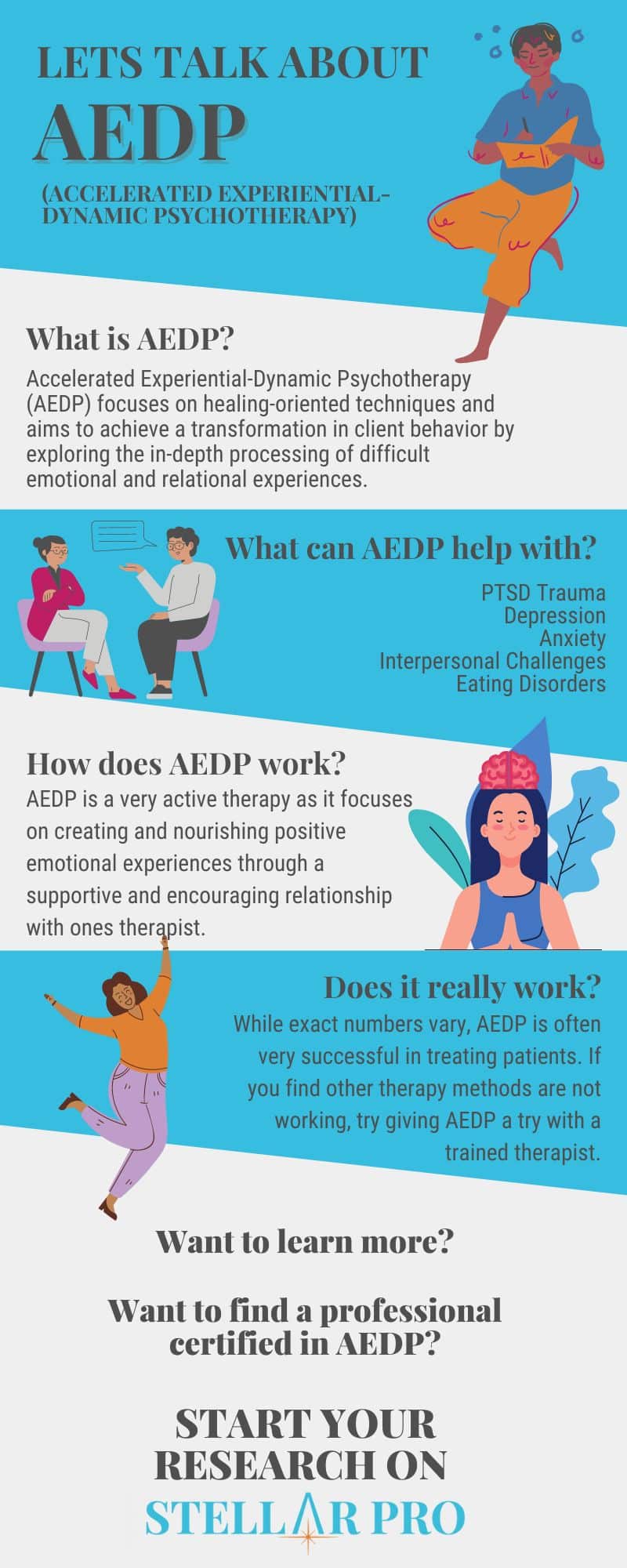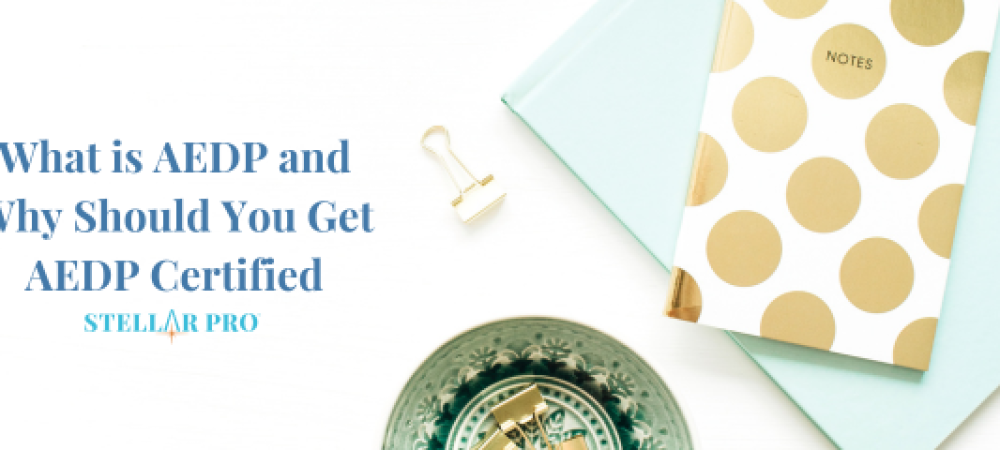Accelerated Experiential Dynamic Psychotherapy (AEDP) is a therapeutic framework and set of techniques that focuses on helping clients to access reparative emotions, become aware of and transform their defenses, and develop resources in order to regulate nervous system activation. AEDP is an evidence-based therapy that has been found to be highly effective in treating individuals with trauma and other psychiatric conditions.
AEDP certification involves completing an intensive training program designed to help mental health professionals learn how to effectively use AEDP techniques to treat their clients. In this article, we will discuss the benefits of getting AEDP certified, what it takes to become a certified AEDP therapist, and why you should get your AEDP certification today.
What is AEDP?
Accelerated Experiential Dynamic Psychotherapy, or AEDP, is a therapeutic approach that emerged in the 1990s, developed by Dr. Diana Fosha. AEDP was created for individuals who have experienced trauma, and it aims to address the underlying emotions that come with such experiences. According to Dr. Fosha, AEDP “seeks to transform the negative impacts of attachment trauma, losses and ongoing life stresses into vehicles for healing and growth.”
AEDP works by combining experiential and dynamic elements to heal emotional trauma. The therapy is designed to help clients access and transform stuck emotional patterns, and to integrate positive experiences into the sense of self.
The main idea behind AEDP is to create a secure, empathic environment where clients feel safe to explore their emotions. This is achieved through the therapist’s attunement to the client’s emotional state, allowing them to form a deep connection based on trust and support.
AEDP is for anyone looking to heal emotional wounds, including past experiences of trauma, anxiety, and depression. The therapy can be beneficial not only for individuals but also for couples, families, and groups.

How Does AEDP Work?
AEDP, or Accelerated Experiential Dynamic Psychotherapy, is an innovative and integrative psychotherapy model that seeks to address the root causes of emotional distress by tapping into the innate capacity for healing within each individual. The therapeutic approach aims to help individuals identify, process, and integrate core emotions that have been buried or avoided as a result of painful life experiences. By helping individuals become more aware of and connected to their emotions, AEDP facilitates the healing of emotional wounds, reduces symptoms of anxiety and depression, and fosters a sense of resilience and well-being.
AEDP works through a structured therapy process that includes four stages:
Stage One: Creating Safety and Connection focuses on establishing a secure therapeutic relationship between the therapist and patient, building a sense of safety and trust that enables the patient to explore their inner emotional landscape.
Stage Two: Processing Emotional Experience involves helping the patient to identify and process core emotions that have been avoided or suppressed, transforming negative self-schemas, and experiencing profound emotional change.
Stage Three: Consolidation involves consolidating the gains through interventions to enhance resilience and promote the integration of new experiences into daily life.
Stage Four: Integration and Transformation involves finalizing the healing process by integrating the gains into a comprehensive sense of self, positive relationships, and the wider world.
If you are a psychotherapist, counselor, or mental health practitioner looking to upskill and differentiate yourself from your peers, AEDP certification can be a wise investment in your professional development. AEDP certification entails attending intensive seminars, receiving clinical supervision, and participating in ongoing training to develop expertise in the AEDP model. Pursuing AEDP certification not only provides you with deeper insights into the human psyche and a broader range of interventions to apply in your clinical practice but also helps you attract and retain clients who want to receive this evidence-based, compassionate, and powerful form of psychotherapy.
Who is AEDP For?
AEDP (Accelerated Experiential Dynamic Psychotherapy) is a thoughtful and comprehensive approach to psychotherapy that can make a significant positive impact on a wide range of people. AEDP is an evidence-based therapy model that integrates relational, experiential, and neurobiological approaches to help clients access and process emotional experiences. AEDP is suitable for individuals experiencing a wide range of mental health issues; however, it’s particularly effective for clients with a history of trauma, attachment difficulties, and clients struggling with emotional regulation. According to Dr. Fosha, the founder of the AEDP Institute, “AEDP is for any clinician who wants to become an even better therapist, as well as any client who wants to heal, feel more alive, and live more fully.” By becoming AEDP certified, therapists can develop and sharpen their skills, learning how to harness the innate capacity for emotional resilience that lies within every client. Key aspects of AEDP include “undoing aloneness” and “making the implicit explicit” as well as fostering emotional transformation through secure attachment, emotional expression, and vulnerability. AEDP is a powerful and proven therapeutic approach that has helped countless individuals achieve greater emotional health and wellbeing.
Benefits of AEDP
Accelerated Experiential Dynamic Psychotherapy (AEDP) is a form of therapy that focuses on creating a secure emotional bond between the therapist and the client, resulting in rapid and revolutionary changes in the client’s behavior and emotions. AEDP therapists provide a supportive atmosphere that inspires individuals to understand and work through their emotional and relational difficulties. The therapy works by tapping into one’s innate healing capacities and allowing the person to notice and experience their emotions in ways that were previously impossible.
The benefits of AEDP are numerous, including the ability to help people address the deep-seated emotional issues that underlie many common problems like anxiety and depression. By utilizing a wide range of techniques, including visualization, bodywork, and empathy, AEDP can help individuals develop deep connections with their inner selves and establish stronger, more fulfilling relationships.
One of the key benefits of becoming AEDP certified is the ability to provide clients with a powerful, life-changing therapy that can help them overcome a wide range of emotional difficulties. AEDP certification also demonstrates to potential clients and employers that you possess the skills and knowledge required to provide high-quality therapy services.
In addition to being one of the most effective forms of therapy available, AEDP is also backed by extensive research and has been shown to produce significant improvements in individuals’ mental well-being. It’s a versatile therapy that can be used to treat a wide range of emotional and psychological issues, including PTSD, anxiety, depression, and more.
Why Should You Get AEDP Certified?
Accelerated Experiential Dynamic Psychotherapy, or AEDP, is a psychotherapeutic approach that aims to create a secure and emotionally enriching experience for clients. AEDP involves the integration of various elements from other psychotherapies to help clients connect with their emotions, enhance positive feelings, and overcome negative ones. If you are a mental health professional, getting AEDP certified can offer many advantages.
AEDP is effective for a wide variety of clients.
AEDP is effective for treating clients with several symptoms, such as anxiety, depression, PTSD, and relationship problems. AEDP can help clients experience emotional healing, growth, and transformation.
AEDP Certification demonstrates your expertise.
Getting AEDP certified proves your proficiency in AEDP and other psychotherapeutic approaches. As a result, you can stand out in a crowded field and demonstrate your authority and professionalism.
There is a growing demand for AEDP practitioners.
As mental health issues affect more people than ever, the demand for well-versed and certified psychotherapists is soaring. Many people are looking for alternative psychotherapies that provide promising outcomes, and AEDP is one of them.
As you can see, getting AEDP certified can offer several benefits, including enhanced job opportunities, greater client satisfaction, and better outcomes. For mental health professionals, AEDP certification is a wise investment in your career and your clients’ well-being.
The AEDP Certification Process
Accelerated Experiential Dynamic Psychotherapy, or AEDP, is a method of psychotherapy that has gained popularity for its effectiveness in treating trauma and helping clients develop emotional resilience. AEDP is rooted in attachment theory, and works to provide a safe and secure space for clients to process their emotions and form healthier connections. If you’re interested in becoming an AEDP practitioner, it’s important to understand the certification process.
Here are the steps involved in becoming an AEDP certified therapist:
1. Attend an AEDP Essentials™ course: The AEDP Essentials™ course is an introductory course that provides a comprehensive overview of AEDP’s theory, techniques, and interventions. This course is mandatory for any clinical professional who intends on using AEDP in their practice.
2. Complete the AEDP Immersion Course: The Immersion course is designed to help practitioners develop their skills in using AEDP with clients. This course comprises both didactic and experiential components, and is offered as either an intensive or non-intensive program.
3. Attend an AEDP Essential Skills 1 (ES1) Course: This course provides participants with instruction on how to implement and integrate AEDP techniques into their existing therapeutic practice.
4. Participate in Supervision: Supervision is a requirement for earning AEDP certification. This provides practitioners with the opportunity to gain feedback and guidance on their skills and techniques.
By completing these steps, practitioners can become certified in AEDP and gain the knowledge and skills needed to provide effective and transformative therapy.
Conclusion
Accelerated Experiential Dynamic Psychotherapy is a form of psychotherapy that is based on the theory that change occurs through the experience of dynamic interactions. This type of therapy is often used to treat clients who are struggling with problems such as anxiety, depression, stress, and addiction. The AEDP certification is perfect for therapists who want to specialize in this type of therapy. As a certified AEDP therapist, you will be able to provide better treatment to your patients. You will also be in a better position to attract new clients and increase your income. If you are interested in getting certified in AEDP, be sure to visit our website for more information. We will be happy to help you find the right certification program and guide you through the certification process.




